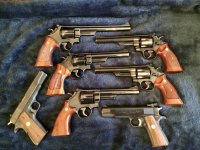Hair Trigger
US Veteran
Some of what I read in the Standard catalog about the Model 25 confuses me. It talks about the long cylinder and short cylinder .45 Colt guns; I know the revolver is also available (and was initially issued) as a .45 ACP, and different dash numbers are either .45ACP or .45 Colt, and the Catalog mentions "few were produced in .45 Colt until 1977 with the 125th Anniversary Commemorative". I assume that means others before that could be special ordered for .45 Colt? Then it says ".45 Colt standard production, long cylinder" began in 1977 with the dash 5.
I'm looking for a M25 in .45 Colt, not interested in .45ACP. Other than the 125th Anniv. model (which is a dash 3) and the dash-5's up to 1982, what other M25's are available in .45 Colt? Are 4" barrels less common than 6", or 8-3/8"?
I have an opportunity for a M25, don't know what dash it is, but it is a 4" .45 Colt and it is a pinned barrel. I can't see enough of it in the display case to guess more about it, but I'm assuming it's a dash-5, as it says "Smith and Wesson" on the left of the barrel, but the anniv. edition has ".45 Caliber" on that side. It looks to be in pretty good shape, I can see a small light scratch on a cylinder flute, but can't see anything on the other side.
So, what else to look for, and what brings the most $$?
I'm looking for a M25 in .45 Colt, not interested in .45ACP. Other than the 125th Anniv. model (which is a dash 3) and the dash-5's up to 1982, what other M25's are available in .45 Colt? Are 4" barrels less common than 6", or 8-3/8"?
I have an opportunity for a M25, don't know what dash it is, but it is a 4" .45 Colt and it is a pinned barrel. I can't see enough of it in the display case to guess more about it, but I'm assuming it's a dash-5, as it says "Smith and Wesson" on the left of the barrel, but the anniv. edition has ".45 Caliber" on that side. It looks to be in pretty good shape, I can see a small light scratch on a cylinder flute, but can't see anything on the other side.
So, what else to look for, and what brings the most $$?
Last edited:






